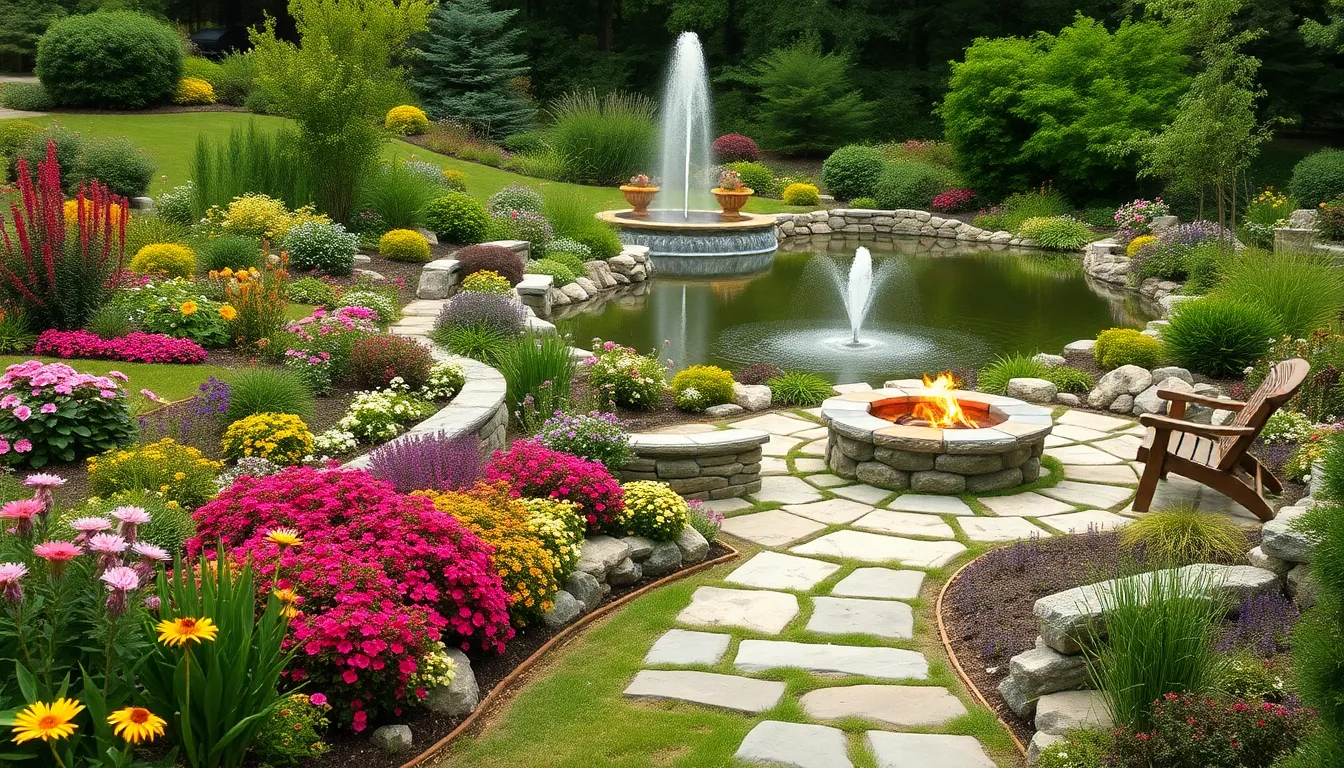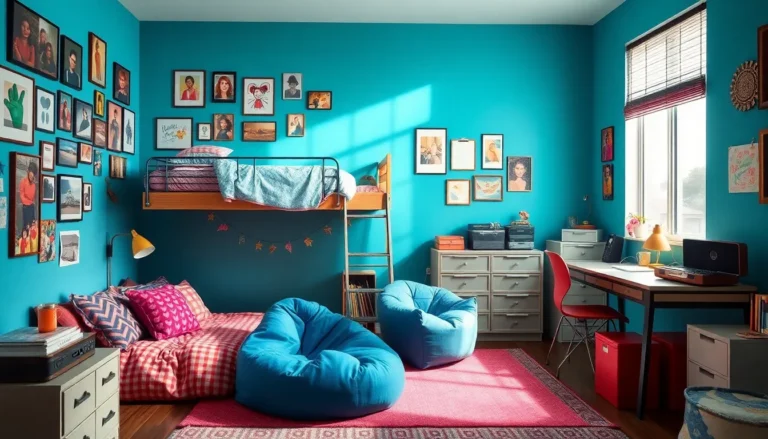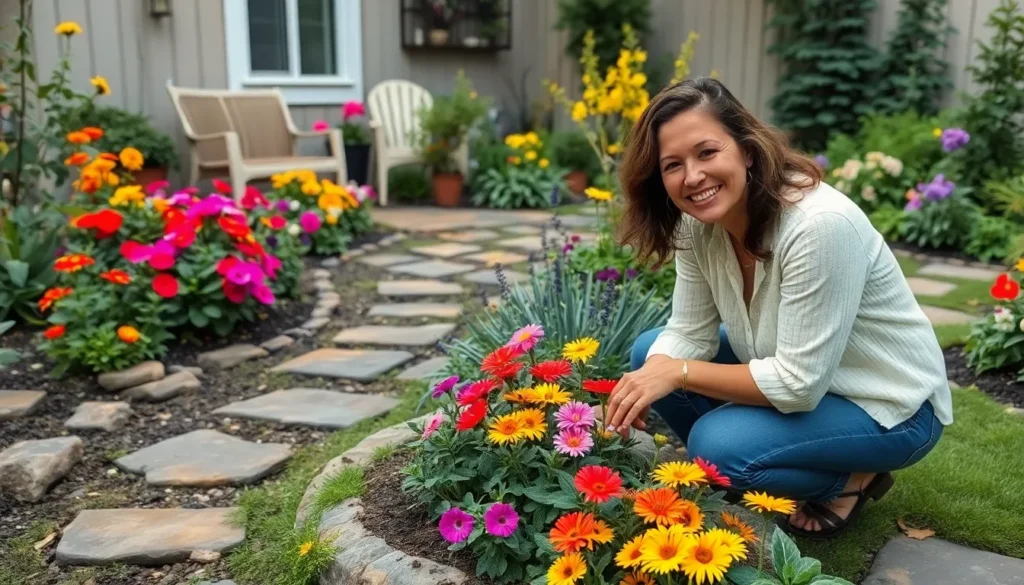Table of Contents
ToggleImagine stepping into your backyard and feeling like you’ve just entered a botanical paradise. Garden landscaping isn’t just about planting flowers; it’s about creating a sanctuary that reflects personality and style. With the right design, even the tiniest patch of earth can transform into a vibrant oasis that makes neighbors green with envy.
Overview Of Garden Landscaping
Garden landscaping encompasses various elements that contribute to the overall aesthetic and functionality of outdoor spaces. Design techniques, such as color schemes, layouts, and plant selection, form the core of an effective landscaping strategy. Plants add visual interest and provide habitat for wildlife. Choosing a diverse array of flowers, shrubs, and trees creates seasonal beauty and ecological balance.
Creating pathways enhances mobility and guides visitors through the garden. Materials like stone, gravel, or mulch can establish a distinct character while providing practical benefits. Hardscaping features, such as patios, retaining walls, and water features, complement the greenery, adding depth and dimension to the landscape.
Sustainable practices, including native plant selection and efficient irrigation systems, support an eco-friendly approach. Utilizing drought-resistant plants minimizes water usage and maintenance costs. Incorporating rain gardens can manage runoff and promote biodiversity.
Lighting plays a crucial role in garden landscaping, illuminating pathways and highlighting key features. Strategic placement of fixtures enhances safety and creates an inviting ambiance after sunset. Sunglight accessibility must be considered when selecting plants, ensuring they thrive in their designated spots.
Experiential aspects, such as seating and gathering areas, encourage social interaction and relaxation. Outdoor furniture can define spaces and offer comfort for gatherings. Seasonal decorations and themes add a personal touch, making the landscape truly unique.
Garden landscaping requires careful planning and execution, ultimately transforming outdoor spaces into serene retreats that reflect personal style. Balancing aesthetics with functionality within the landscape leads to an inviting environment for both residents and guests.
Key Elements Of Garden Landscaping

Garden landscaping incorporates various elements that blend aesthetics with functionality. Understanding these components can significantly enhance outdoor spaces.
Plants And Flowers
Selecting the right plants and flowers is crucial for color and texture. Consider native plants that thrive in local climates; they require less maintenance. Create layers with tall plants at the back and shorter ones in front. Choose flowers that bloom at different times to ensure year-round visual interest. Incorporating fragrant plants can also entice visitors and enhance the sensory experience.
Hardscaping Features
Hardscaping refers to non-plant elements that structure a garden. Paths made from stone or gravel guide movement and define spaces. Patios provide areas for seating, allowing for outdoor gatherings. Retaining walls can add depth to sloped landscapes while providing necessary support. Fire pits or outdoor kitchens introduce functionality and warmth, making gardens inviting year-round.
Water Elements
Water features can enhance tranquility in any garden setting. Fountains create soothing sounds that mask noise and attract wildlife. Ponds offer habitats for fish and aquatic plants, enriching biodiversity. Incorporating a small stream can bring movement and interest to the landscape. Additionally, rainwater harvesting systems can promote sustainability while serving decorative purposes.
Popular Garden Landscaping Styles
Various garden landscaping styles exist, each offering unique aesthetics and features. The following styles enhance outdoor spaces and reflect individual preferences.
Modern Landscaping
Modern landscaping emphasizes clean lines and minimalist designs. This style often incorporates geometric shapes and a limited color palette, showcasing contemporary materials such as concrete and metal. Plant selection focuses on low-maintenance species, promoting sustainability and eco-friendliness. Large planters and raised beds frequently feature in these designs, enhancing visual appeal. Water elements like reflecting pools add serenity and sophistication, creating an inviting atmosphere.
Cottage Garden Style
Cottage garden style embraces a romantic and chaotic approach to plant arrangement. This style combines diverse flowers, herbs, and vegetables often grown in abundance. An informal layout includes winding paths and rustic elements like picket fences or trellises. Colorful blooms such as roses and daisies evoke charm and nostalgia. Gardeners typically prioritize biodiversity in this style, attracting pollinators and creating a vibrant ecosystem. Additionally, natural materials like stone or wood complement the overall design, fostering a sense of connection to nature.
Xeriscaping
Xeriscaping promotes water conservation through efficient landscape design. This style incorporates drought-resistant plants, requiring minimal irrigation. Native species flourish in xeriscaped gardens, adapting well to local climates. Elements such as gravel pathways and mulch beds minimize weeds while enhancing visual texture. Rainwater harvesting systems often complement this approach, capturing water for irrigation purposes. By emphasizing sustainability, xeriscaping creates attractive yet functional spaces, reducing maintenance and environmental impact.
Tips For Effective Garden Landscaping
Effective garden landscaping requires thoughtful strategies and details. Incorporating various elements ensures a harmonious outdoor space that reflects personal style.
Planning And Design
Begin with a clear vision for the garden. Identify the primary purpose of the landscape, whether it’s relaxation, entertainment, or gardening. Research suitable plants that thrive in the local climate and soil conditions. Consider the layout carefully, incorporating paths, seating areas, and features that invite movement. Utilize diverse colors and textures to create visual interest throughout the seasons. Plan relocation or transplanting needs for established plants to fit the evolving design. Survey the space’s natural light and wind patterns to enhance plant health and enjoyment.
Maintenance Considerations
Maintain landscape health through regular upkeep. Watering practices should align with plant requirements and seasonal variations. Pruning encourages growth and keeps plants tidy, contributing to overall aesthetics. Mulching retains moisture and suppresses weeds effectively. Schedule seasonal checks for pests and diseases to implement timely interventions. Fertilization provides essential nutrients, ensuring vigorous growth. Time and resources allocated to maintenance promote a thriving garden, transforming the outdoor space into a resilient, beautiful retreat.
Garden landscaping is an art that combines creativity and practicality. By thoughtfully designing outdoor spaces, individuals can create a personal retreat that reflects their unique style. The right mix of plants, hardscaping, and experiential elements can transform any yard into a stunning oasis.
Investing time in planning and maintenance ensures that these outdoor spaces thrive throughout the seasons. With careful attention to detail, anyone can enjoy a beautiful garden that not only enhances their property but also contributes positively to the environment. Embracing the principles of garden landscaping opens the door to endless possibilities for creating a vibrant and inviting outdoor sanctuary.







